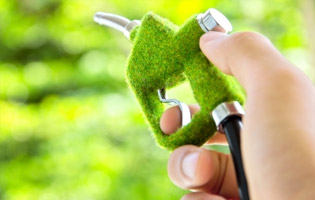 As fuel in bio-fireplaces, a liquid called biofuel, bioethanol or simply ethanol is used. It is 96% ethyl alcohol (C2H5OH) containing some water and special additives.
In accordance with legal regulations in force, producers are obliged to add contaminants preventing people from drinking the alcohol by giving it a repulsive flavor. This process is called denaturation. The types of additives and the clarity of alcohol determine the fuel’s quality. High quality biofuels burn with a nice yellow and orange flame and do not exude any smell. In order to be sure that during incineration no dangerous substances are emitted, you should buy only fuels with appropriate certificates.
Bioethanol is produced in the process of fermentation from annual plants such as potatoes, grains or corn. Ethanol is believed to be an ecological fuel, renewable and environmentally friendly. During its incineration only carbon dioxide and water vapor are produced. Those substances are reused by plants to grow, so the burden on environment is neutral.
As fuel in bio-fireplaces, a liquid called biofuel, bioethanol or simply ethanol is used. It is 96% ethyl alcohol (C2H5OH) containing some water and special additives.
In accordance with legal regulations in force, producers are obliged to add contaminants preventing people from drinking the alcohol by giving it a repulsive flavor. This process is called denaturation. The types of additives and the clarity of alcohol determine the fuel’s quality. High quality biofuels burn with a nice yellow and orange flame and do not exude any smell. In order to be sure that during incineration no dangerous substances are emitted, you should buy only fuels with appropriate certificates.
Bioethanol is produced in the process of fermentation from annual plants such as potatoes, grains or corn. Ethanol is believed to be an ecological fuel, renewable and environmentally friendly. During its incineration only carbon dioxide and water vapor are produced. Those substances are reused by plants to grow, so the burden on environment is neutral.
As fuel, ethanol is very energetically efficient as compared to wood, for instance. Its caloric value amounts to about 30 MJ/kg, while for wood it is only about 15 MJ/kg.
The density of ethanol amounts to 0.8 kg/l. Therefore, in case of a fire, it should not be extinguished with water. The best solution is to use a fire blanket or a dry-powder extinguisher (cars are equipped with such).
The usage of biofuel depends on the power of the furnace, which is an average of 0.15 l per hour for one kW.
As a result of the incineration of biofuel, carbon dioxide and water are produced. It is interesting to compare a bio-fireplace with a human being. On average, one person exudes about 1 kg of carbon dioxide in 24 hours – as much as after burning about 0.7 l of ethanol. Therefore, the work of a bio-fireplace of the power of 1 kW (for instance the Manacor, size M) reflects the emission of carbon dioxide breathed out by about five people, which explains why rooms in which bio-fireplaces are used in winter should have an appropriate volume and at least standard ventilation. You can also open the window if it becomes too stuffy.





 Poland, Warsaw, Wólczyńska Street 208
Poland, Warsaw, Wólczyńska Street 208 +48 22 817 95 55, +48 22 817 95 54, +48 22 462 32 68
+48 22 817 95 55, +48 22 817 95 54, +48 22 462 32 68